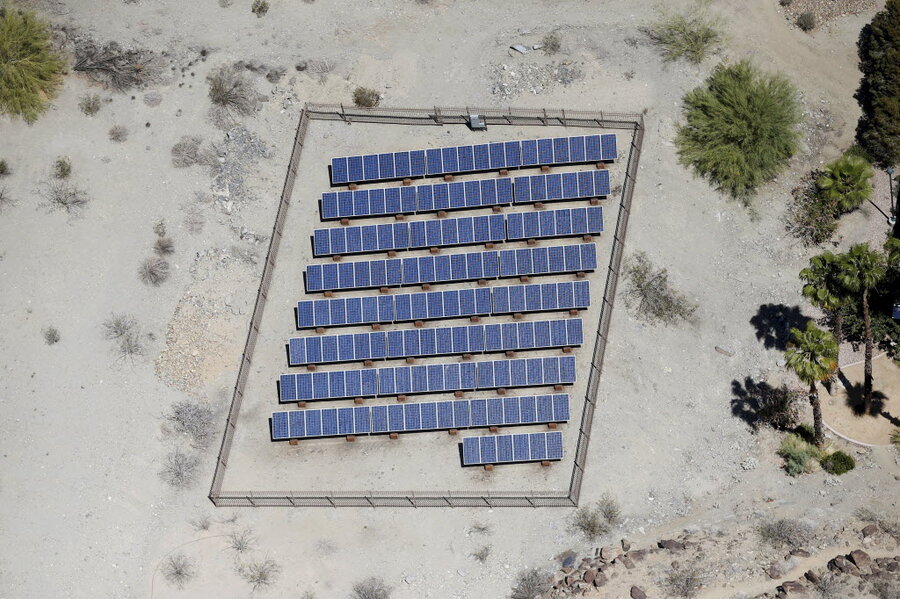IEA: Global power balance tipping irreversibly toward renewables
| Washington
Last year, renewables accounted for nearly half of the world’s new power generation supply. From now until at least 2040, wind, solar, and other alternative sources will be the No. 1 source of new energy supply across the globe. Within two decades, zero-carbon, infinitely replenishable resources will overtake carbon-heavy coal as the world’s largest source of electricity generation.
Those are the findings and projections of the latest annual World Energy Outlook by the Paris-based International Energy Agency (IEA) – an organization that has a history of underestimating just how fast renewable energy will expand. The tilt toward cleaner fuels is a promising sign just weeks before a major climate summit in Paris, where diplomats from nearly 200 countries will craft an agreement to dramatically slash greenhouse-gas emissions.
Despite the accelerating growth, renewables today still make up only a small fraction of global energy use. The IEA report confirms that current climate pledges will overshoot the goal of keeping global warming within 2 degrees Celsius. More must be done to decarbonize the global energy supply, analysts warn, if we are to avert the worst impacts of climate change.
"As the largest source of global greenhouse-gas emissions, the energy sector must be at the heart of global action to tackle climate change," IEA Executive Director Fatih Birol said in a press release. "World leaders meeting in Paris must set a clear direction for the accelerated transformation of the global energy sector.”
Tuesday’s report offers an optimistic counterpoint to a core underlying concern about ballooning carbon emissions – namely, that they are the inevitable result of increased economic prosperity. Developing nations will continue to drive rising global energy demand as more people across the globe move into the middle class, but Tuesday’s report suggests that renewables will meet a larger share of that new demand than previously expected.
As renewable energy sources become more ubiquitous, the link between CO2 emissions and economic growth grows more tenuous, experts say.
"Historically, energy-related CO2 emissions have moved in lockstep with economic growth,” says Doug Vine, senior energy fellow at the Center for Climate and Energy Solutions, a Washington-based climate research organization. “But for the first time last year, global carbon dioxide emissions leveled off while the world economy grew.”
One year’s data doesn’t make a trend, Mr. Vine concedes, but it could be a sign that economic growth and carbon emissions are “decoupling”. Climate observers say renewables will play a central role in allowing countries to meet their commitments to reduce carbon emissions under the UN climate talks . Plummeting wind and solar power costs will only accelerate the trend, especially as fossil fuels become more difficult and expensive to extract.
Global energy use is expected to grow by one third between now and 2040, according to IEA. But non-fossil fuel energy sources should expand during that period to cover 25 percent of the world’s energy needs, up from 19 percent today. The power sector will play a particularly central role in decarbonizing the energy market. By 2040, renewables will account for half of the European Union’s electricity generation. China and Japan will get 30 percent of its power from non-fossil sources by 2040, while renewables make up more than a quarter of power generation in the US and India.
Leading the surge in demand for energy are developing countries that are not members of the Organization for Economic Cooperation and Development (OECD). In 2014, these countries accounted for 7 out of every 8 additional units of electricity. They are also expected to drive investment in renewables, as 60 cents from every dollar invested in new power plants between now and 2040 will go to renewable energy.
As part of its pre-Paris climate pledge, India plans to cover 40 percent of its electricity needs with non-fossil sources by 2030. While India only accounts for 6 percent of global energy use today, its energy consumption grew more than any other single country in 2014. Currently, one fifth of India’s population does not have access to electricity, but it’s the No. 3 emitter behind China and the US.
Demand for coal and oil are expected to increase in India as the country continues to develop, but officials have also expressed their intention to boost India’s economy by transforming the country into a clean tech hub.
Increased energy efficiency is also helping to reduce greenhouse-gas emissions. In 2014, mandatory efficiency regulations expanded to cover over a quarter of global energy consumption. China, currently the world’s largest emitter of greenhouses gasses, has nevertheless improved its energy efficiency over the past decade.
Of course, these optimistic projections don’t mean the battle against climate change has been won. As the authors of the report note, these inroads do not put us on the path toward limiting global warming to 2 degrees C above pre-industrial levels, the temperature scientists warn will cause irreversible damage to the planet. But experts are confident that the increased use of renewables will allow countries to increase their efforts to reduce carbon emissions in the future, especially as renewables become the leading source of new energy between now and 2040.
Analysis from the World Resource Institute demonstrates that over half of the climate pledges submitted have renewable energy targets in them, leading renewable energy supplies in the 8 largest emitters to almost double collectively by 2030, says says Taryn Fransen, project director at the World Resource Institute.
“The Paris Agreement can build on this by putting in place a strong process to keep countries coming back to the table to strengthen their commitments,” says Ms. Fransen.






